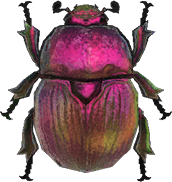Difference between revisions of "Earth-boring dung beetle"
From Nookipedia, the Animal Crossing wiki
(re-generate languages) |
|||
| Line 14: | Line 14: | ||
|image= Earth-Boring Dung Beetle NH.png | |image= Earth-Boring Dung Beetle NH.png | ||
|scientific name= - | |scientific name= - | ||
| − | |family= | + | |family= Geotrupidae |
|timeyear= [[July]] to [[September]] (Northern Hemisphere)<br>[[January]] to [[March]] (Southern Hemisphere) | |timeyear= [[July]] to [[September]] (Northern Hemisphere)<br>[[January]] to [[March]] (Southern Hemisphere) | ||
|timeday= All day | |timeday= All day | ||
Revision as of 19:36, August 2, 2020
The Earth-Boring Dung Beetle is a bug introduced in Animal Crossing: New Horizons that can be found all day from July to September (in the Northern Hemisphere). It sells for 300 Bells.
Catch details
In New Horizons
| Time of year | North: Jul – Sep South: Jan – Mar |
|---|---|
| Time of day | All day |
| Location | On the ground |
| Weather | Any weather |
| Spawn requirement | Appears from the start of the game |
| Selling prices | |
| Furniture size |
Donating to the museum
In New Horizons
"Earth-boring dung beetles are considered quite handsome by some, thanks to their metallic luster. In fact, some even think them to be good omens and bringers of favorable fortune. But I must protest! These field- ravaging pests love to burrow under piles of dung and lay their eggs. They raise their young under DUNG! Need I say more? Ick. I think not."
Names in other languages
| オオセンチコガネ ō-senchi-kogane |
Large geotrupid (lit. "large snow-hiding scarab") | |
| 보라금풍뎅이 borageumpungdeng-i |
Purple geotrupid | |
| 雪隐金龟 xuěyǐn jīn’guī |
"Snow-hiding scarab", from Japanese name | |
| Навозник-землерой Navoznik-zemleroy |
Geotrupid | |
| Echte mestkever | Geotrupid (lit. "true dung beetle") | |
| Gold-Mistkäfer | Gold dung beetle | |
| Escarabajo geotrúpido | Geotrupid beetle | |
| Geotrupidae | ||
| Géotrupe | From family name | |
| Geotrupidae | ||
This article or section requires further research about real life information.
You can help by investigating this topic and editing this article to include more information. Relevant discussion may be found on the talk page.
This article or section requires further research about real life information.
You can help by investigating this topic and editing this article to include more information. Relevant discussion may be found on the talk page.
| Bugs | ||||||||||||||||||||||||||
|---|---|---|---|---|---|---|---|---|---|---|---|---|---|---|---|---|---|---|---|---|---|---|---|---|---|---|
| ||||||||||||||||||||||||||
